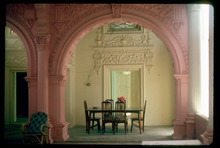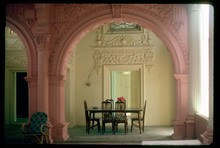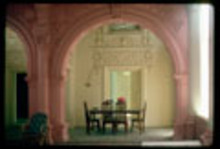| dc.coverage.spatial | Site: remaining facade, Hyderabad (Andhra Pradesh, India) | en_US |
| dc.coverage.temporal | creation date: late 18th century, alteration date: remodeled in European fashion, late 19th century, destruction date: falls into disuse, 20th century | en_US |
| dc.creator | Bahadur, Nawab Vikar-ul-Umra | en_US |
| dc.creator | Shams al-Umara I | en_US |
| dc.date | late 18th century | en_US |
| dc.date.accessioned | 2007-10-25T13:36:16Z | |
| dc.date.available | 2007-10-25T13:36:16Z | |
| dc.date.issued | 1770-1791 | en_US |
| dc.identifier | 112156 | en_US |
| dc.identifier.uri | http://hdl.handle.net/1721.3/21849 | en_US |
| dc.description | Located in Shahganj, Shams al-Umara I built the deori in the late 18th century in an oriental style. His successor Sir Wiqar al-umara II, who also had the title of Iqbaluddawlah (1856-1902) remodeled portions of the palace after European fashion to entertain foreign visitors. It is often referred to as the city palace, deori baldah, in contradiction to the Falak Numa Palace and the Paigah Palace he built in the then suburbs of the city. The palace consisting of four quadrangles with a central cistern was divided into zenana and sleeping quarters, dining, drawing rooms, and offices. The palace fell into disuse after the nobleman’s move to Paigah Palace in Begumpet at the turn of the 20th century. The portion surviving in 2006 consists of a façade facing the street with projected and canopied windows. | en_US |
| dc.description | interior, archway in diwan khana, drawing room, 1986 | en_US |
| dc.format.medium | masonry | en_US |
| dc.format.medium | stone | en_US |
| dc.relation.ispartof | 130508 | en_US |
| dc.rights | (c) Arjun Mangaldas 1986 | en_US |
| dc.subject | Palaces | en_US |
| dc.subject | Islamic cities and towns | en_US |
| dc.subject | Architecture, Islamic --India | en_US |
| dc.subject | Lost architecture | en_US |
| dc.subject | Paigah family | en_US |
| dc.subject | Anglo-Mughal | en_US |
| dc.subject | Architecture, Oriental | en_US |
| dc.subject | Deccan (India) | en_US |
| dc.subject | Arches | en_US |
| dc.subject | Drawing rooms | en_US |
| dc.title | Deori Iqbaluddawlah | en_US |
| dc.type | Image | en_US |
| dc.rights.access | All rights reserved | en_US |
| dc.identifier.vendorcode | 10-1 | en_US |
| vra.culturalContext | Indian (South Asian) | en_US |
| vra.culturalContext | Islamic | en_US |
| vra.technique | construction | en_US |
| vra.worktype | Palace | en_US |
| dc.contributor.display | patron: Shams al-Umara I (Indian (South Asian), died 1791), patron: remodeled by Nawab Vikar-ul-Umra Bahadur (Indian (South Asian), 1856-1902) | en_US |



